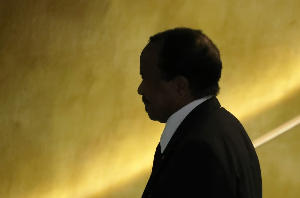A popular saying goes that where a road passes, development follows. Added to the roads, whose contribution to the socio-economic life of man and nation need no insistence, are other infrastructure projects of national interest like schools, hospitals, stadiums et al. The quantity of the projects is as important as their quality. The two are interwoven for change to come.
Countries aspiring for emergence imperatively need infrastructure projects worth the name. Cameroon has slightly over 10 per cent of her roads paved. Considerable efforts are on course to augment the quantity of the tarred national roads so as to make them passable all season.
This is evident in the number of road projects spread across the country ranging from fresh pavement to rehabilitation.
As good as this sounds, there are vexing problems that must be handled and urgently too if the country must continue on the already charted growth path and aspire to attain desired goals. Efficiency in the execution of infrastructure projects; all categories inclusive, is not supposed to be an option.
Curiously, the country seems to be wanting therein. If not, what justifies the fact that a project as important as the Sangmelima-Mekok-Bikoula stretch, part of the trans-national Sangmelima-Djoum-Mintom road linking Cameroon and Congo Brazzaville, is not evolving satisfactorily.
In fact, in an inspection tour to the site Monday, Public Works Minister, Patrice Amba Salla came face-to-face with the disheartening reality not only that the project was at a snail-pace but equally that the executing and control firms did not abide by takeoff engagements.
The rate of execution is dismally at 23.68 per cent even as the contracting Iranian firm, Kayson Inc, is already beyond the required deadline. The FCFA 23.3 billion project jointly financed by the Islamic Development Bank and the government of Cameroon had a 30-month execution period (13 October 2012- 12 April, 2015).
Although justifications; tenable or not, were given to explain the disturbing delay, one thing stands out here. There seems to be a general problem of efficiency in the execution of public infrastructure projects in the country.
Apparently, there is a missing link between the conception, feasibility studies, sourcing for financing, awarding contracts, control and effective execution of projects. Actors of the Sangmelima-Mekok-Bikoula road are still talking about compensation of the affected population at a time the executing firm was expected to have delivered the goods.
There is still talk about the lengthy and complicated procedure in disbursing the financing for the project. Worse still, the control firm is said to have been given a below-average performance. Why are all of these happening only now? What has been happening in the last three years that the Iranian outfit won the contract? What were the criteria for selecting the firm and not others that took part in the competitive tender bids, if there were any? Indeed, more questions begging for answers.
The project in question raises a deep-rooted syndrome of cosmetic synergy whose effects are devastating in the infrastructure sector. Such projects are by nature time-consuming and cash-draining. Before engaging them, there is need for all who matter in its execution chain to carryout preliminary works that could enhance efficiency. Government under which the projects are executed needs to function like a human body where one part absolutely needs the other to operate at maximum.
Better feasibility studies are therefore imperative before engaging donor agencies for funding and the contractor and controller for their execution.
Transparency and objectivity equally need to prevail here. As a matter of fact, all actors must work as a team, with each playing his/her role efficiently without necessarily playing inferior or superior.
Anything contrary to this is misunderstanding between public actors and sometimes complicity among the contractor and controller with damaging consequences on the quality of infrastructure projects served the population.
All these lead to delays in projects’ execution and quite often impacting their costings; talk less of nefarious effects on the image of the country in the eyes of investors as well as the development vision of the country.
Opinions of Thursday, 7 May 2015
Auteur: Cameroon Tribune















